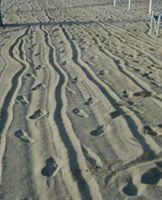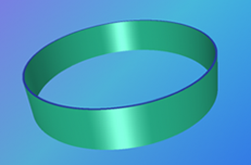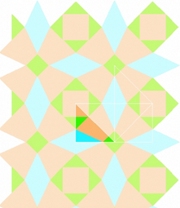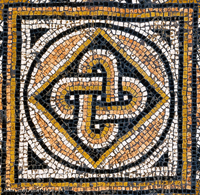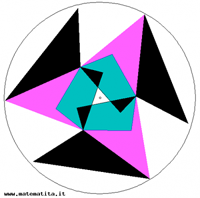From the point of view of symmetry, when we look at a plane drawing, or at a 3d object, the algebraic structure which charachterizes it is its symmetry group, that is the set of all the isometries (plane isometries, or isometries of 3d space) which leave the plane drawing (or, respectively, the 3d object) unaltered.
Let us start, for example, from a drawing which repeats in the plane through a translation (like this, which we should imagine repeating at infinity both right and left); its symmetry group contains just translations: of 1 step, 2 steps, …, n steps, … , but also 0 steps (corresponding to staying still), or 1 step in the opposite direction, … or m steps in the opposite direction.
Let us imagine now to identify, as if they were just one point, all the points which are obtained one from the other through an element of the group (in mathematics this set of points is called an orbit and it is from this word that originates the word orbifold, which stands for orbit manifold.
If we fix (for example) the point corresponding to the tip of the big toe of a given foot, then the translation by one step sends this point to the tip of the big toe of the following foot, … and the translation by seven steps sends it to the tip of the big toe of the foot which is placed seven steps further away, and so on.
So, identifying to just one point all the points of the orbit means that we have just one point corresponding to the tip of the big toe, which is there to represent all the points which correspond to the tip of a big toe in any one of the feet.

Of course, we must do this not only for the point at the tip of the big toe, but for any other point, for the other toes, and for a particular point in the heel, etc; in order to understand what we get at the end of this process, we can place a part of the plane containing just one foot, for example a vertical strip that is one step large, and we can observe that all the points in the interior of this strip will not be identified (we don’t find a translation of one or more steps sending one into the other), while we should still identify the two vertical lines bounding the strip, which are obtained one from the other one just with a one-step translation.
Thus, we get a cylinder and this cylinder represents the quotient of the plane with respect to the symmetry group of the drawing (sometimes we will call it the quotient of the drawing, referring to the motif – here it is just one foot – which is drawn on the cylinder). Also for these drawings the quotient is a cylinder.
The interesting point is that we can imagine this cylinder as a “stamp” (just like a painting cylinder) which, when decorated with a certain motif, can reproduce on the plane the drawing we started from.
And this is exactly what makes the quotient a “significant” point of view: it is the (mathematical) object which contains, concentrated, all the informations we need in order to reconstruct the drawing we started from.
Also when we start from the drawing of the footprints in a normal walking, if we want to find the quotient, we get to detect a strip in the plane, which is bounded by two parallel lines: this time, however, in order to send a strip (containing for example just a right footprint) to the next one (containing a left footprint) we don’t need a translation but a glide reflection. Thus, as before, the two parallel lines bounding the strip are identified, but now they are identified “the opposite way round”: the result is not a cylinder any more, but it is a Moebius strip.
Let’s see another example. If we put some tiles in a mirror box we see a drawing and we can study its symmetry group; in order to understand the quotient of the plane with respect to this group, let us consider a point, for example the center of one of the small green squares: this point will be identified in the quotient with all the centers of all the green small squares (because, for any couple of green small squares, we can find an isometry which does not change the global drawing and sends the two squares – so also their centers – one to the other). However, the center of a green square will not be identified, for example, to the center of one of the big orange squares (because there does not exist an isometry fixing the drawing and sending one of these two points to the other one). If we move our attention to a vertex of the small green square, we discover that a rotation of 90° around the center of the square (which is an isometry sending the global drawing to itself!) sends this point to a different vertex of the same square (and, by iterating the same rotation, we can send it in each one of these vertices); this means that in the quotient we have a single point representing all the 4 vertices of all the green small squares.
Finally, the quotient is just the triangle corresponding to the mirror box and also this, just like the painting cylinder, acts as a “stamp” which can reproduce a drawing on the plane with the given symmetry group: the “motif”, corresponding to the drawing to be painted on the painting cylinder, is given now by the tiles we insert into the mirror box.
A last example: an image like this one has a much simpler symmetry group: the only isometries fixing the drawing are the 4 rotations with center in the same point, at the center of the drawing, and angles respectively 90°, 180°, 270° e 360° (the last one being the rotation of 0°, that is the identity, fixing everything). What is the quotient? It is enough to consider a sector of 90°, with vertex in the center of the drawing, and identify the two half-lines which are the boundary of this sector, thus getting a cone.
It is easy to imagine other examples similar to this one: the situation is nearly the same for the symmetry group of this drawing except that the angle corresponding to the “opening” of the cone is now 120° instead of 90°; while in this other drawing we have a narrower cone, corresponding to an angle of 45°. These cones also can be imagined as a stamp: if we decorate them with a motif, we can imagine to use them in order to reproduce on the plane a drawing which repeats the motif drawn on the cone for a certain number of times, depending on the angle of the cone: if we use the same cone and we change the motif drawn on it, we get different drawings with the same symmetry group.
